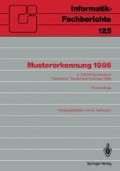Kurzfassung
Es wird der Entwurf eines relationalen Modells im 3D-Raum beschrieben, welches als Grundlage für eine diskrete Relaxation zur Interpretation einer räumlichen Folge von kranialen Röntgen-Computer-tomogrammen dienen soll. Die Modellbildung beinhaltet die drei Schritte der Festlegung einer Menge von Markierungen (engl. set of labels), der Bestimmung der Nachbarschaftsbeziehung (einer Menge von Nachbarschaftsregeln) und die Auswahl geeigneter Relationen, die anschließend für die Beschreibung der zwischen „benachbarten“ Modellelementen geltenden Beschränkungen (engl. constraints) verwendet werden.
Access this chapter
Tax calculation will be finalised at checkout
Purchases are for personal use only
Preview
Unable to display preview. Download preview PDF.
Literatur
MSYS: A System for Reasoning about Scenes, H. Barrow, J.M. Tenenbaum, Techn. Note 121, Stanford Research Inst., A.I. Center, Menlo Park, Calif., 1975
SYNPIC II, M. Bender, C. Fuhrhop, G.A. Schulze, Projekt Computer Vision III, SS 84, Technische Universität Berlin, 1984
Interaktive Erzeugung von synthetischen digitalen Bildmatrizen, S. Blana, B. Böttger, R. Gläser, T. Joerke, G. Kittlitz, H. Neumann, R. Pallaske, C. Pelterson, U. Theißing, A. Westermann, Projekt Computer Vision III, SS 82, Technische Universität Berlin, 1982
Cooperating Processes for Low-Level Vision: A Survey, L.S. Davis, A. Rosenfeld, Artificial Intelligence 17, 1981
Scene Analysis Using Region-Based Constraint Filtering, L. Kitchen, A. Rosenfeld, Pattern Recognition 17, No. 2, 1984
Diskrete Relaxation für die Interpretation von kranialen Computertomogrammen, G. Kittlitz, S. Blana, Diplomarbeit, Technische Universität Berlin, Fachbereich Informatik, November 1985
The RELAX Image Relaxation System: Description and Evaluation, K.I. Laws, G.B. Smith, Techn. Note 301, SRI Proj. 1009, Univ. of Maryland, Menlo Park, CA, 1983
Wissensbasierte Bildanalyse und intelligente Roboter, U. Rembold, P. Levi, Proc. 14. GI-Jahrestagung Okt. 84, Springer, Informatik-Fachberichte 88, 1984
Automatische Verarbeitung und Analyse von kranialen Computer-Tomogrammen, H.S. Stiehl, Dissertation, Technische Universität Berlin, Fachbereich Informatik, 1980
Model-Guided Labelling of GSF-Cavities in Cranial Computed Tomograms, H.S. Stiehl, Proc. 1st Int. Symp. on Computer Assisted Radiology (CAR), Berlin, Juni 1985
IGS: A Paradigm for Integrating Image Segmentation and Interpretation, J.M. Tenenbaum, H.G. Barrow, Pattern Recognition and Artificial Intelligence (Hrsg. C.H. Chen), Academic Press, Proc. Joint Workshop in Patt. Recogn. and Artif. Intell., Juni 1976
Generating Semantic Descriptions From Drawings of Scenes With Shadows, D.L. Waltz, Ph.D. Thesis, M.I.T., A.I. Laboratory, November 1972
Relaxation Labelling, Local Ambiguity, and Low-Level Vision, S.W. Zucker, ‘Pattern Recognition and Artificial Intelligence’ (Hrsg. C.H. Chen), Academic Press, Proc. Joint Workshop in Patt. Recogn. and Artif. Intell., Juni 1976
Author information
Authors and Affiliations
Editor information
Editors and Affiliations
Rights and permissions
Copyright information
© 1986 Springer-Verlag Berlin Heidelberg
About this paper
Cite this paper
Blana, S. (1986). 3D-Modellbildung für die diskrete Relaxation zur Interpretation von kranialen Computertomogrammen. In: Hartmann, G. (eds) Mustererkennung 1986. Informatik-Fachberichte, vol 125. Springer, Berlin, Heidelberg. https://doi.org/10.1007/978-3-642-71387-3_48
Download citation
DOI: https://doi.org/10.1007/978-3-642-71387-3_48
Publisher Name: Springer, Berlin, Heidelberg
Print ISBN: 978-3-540-16812-6
Online ISBN: 978-3-642-71387-3
eBook Packages: Springer Book Archive

